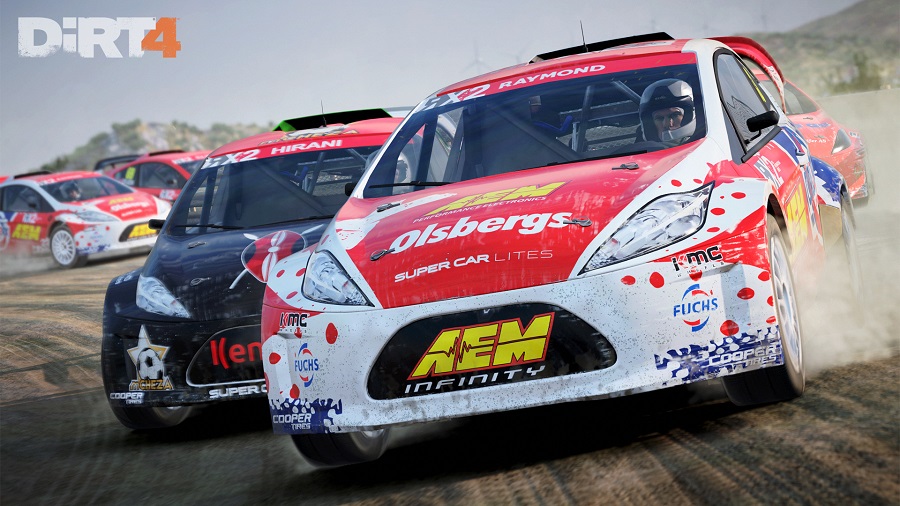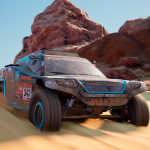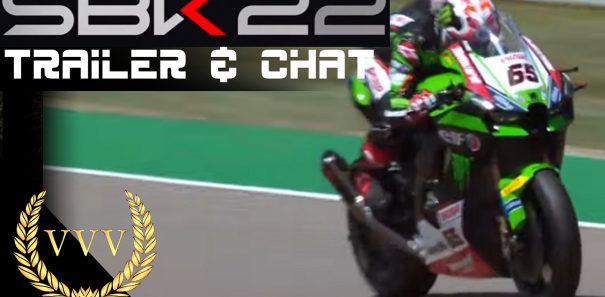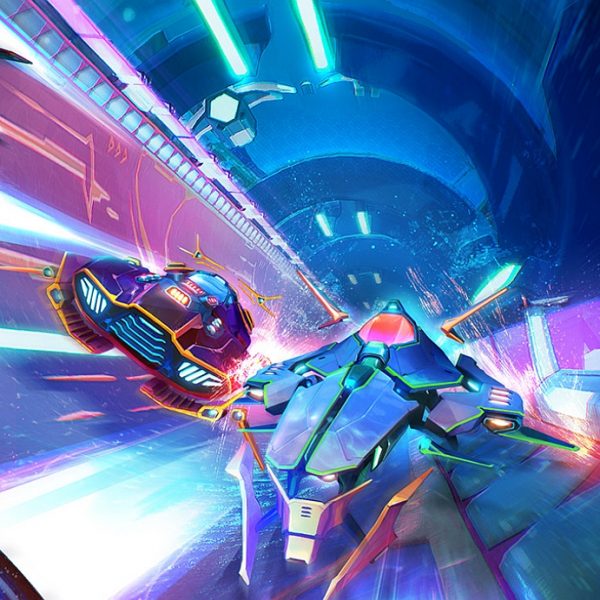The release of DiRT Rally in 2015 captured the sheer intensity of the sport with its uncompromising handling, rough terrain and steep learning curve which would put off all but the most hardened of petrolheads. Three years on and Codemasters’ latest offering sees a return to the numbered titles with DiRT 4.
Rather than a true successor to 2011’s DiRT 3, DiRT 4 is probably best seen as an amalgamation of DiRT 3 and DiRT Rally which aims to appease the sim racer and the more casual gamer alike thanks to its two distinct handling modes of Gamer and Simulation. Can DiRT 4 keep DiRT Rally and DiRT 3 fans happy, or will it fall victim to its own ambition and run the risk of alienating fans of both series?
DiRTinesses
The driving in DiRT 4 is satisfying enough whether you opt for Gamer handling with driver assists or indeed Simulation handling with all assists off. However, DiRT 4 doesn’t feel as uncompromising as DiRT Rally. The cars have more grip, the rally stages are noticeably flatter, and the action lacks some intensity by comparison. Those looking for a true successor to the very demanding DiRT Rally will be left somewhat disappointed by the more accessible nature of DiRT 4. For everybody else, DiRT 4 provides a reasonably challenging and rewarding experience.
One major disappointment in DiRT 4 lays within its environments. It’s bad enough that we only have five rally countries at our disposal, but this disappointment is exacerbated by the visuals which look dated and completely uninspiring. Granted, the “Your Stage” track generator technology behind them is very exciting, but you cannot deny the locations look dull, tired and forgettable compared to other recent racing title offerings.

Fortunately, the vehicle choice fares much better. With over 50 examples on offer, you’re sure to find your favourites. Choices range from the civilised Ford Fiesta right up to a 900bhp Pro-Truck 4 behemoth. A decent smattering of classic rally cars feature, including Group B legends such as the Delta S4 and RS 200, while the iconic Impreza, Escort RS Cosworth and Lancer Evolution VI provide more modern examples: in short, the vehicle choice in DiRT 4 is excellent.
Much like we’ve experienced in DiRT Rally, DiRT 4’s car audio is of a high standard and does a good job of conveying the fact that you are piloting a menacing and powerful purpose-built dirt racing car. Having said that, after comparing cars between the two titles, DiRT 4’s cars sound slightly neutered. Fortunately, most cars still sound satisfying enough: the Metro 6R4 still howls delightfully, and it’s a pleasure to rev the Opel Manta to its redline.
DiRTy business
DiRT 4’s career mode is split into four main categories of Rally, Landrush, Rally Cross and Historic Rally. The very fact that Historic Rally has a category of its own gives you a hint at the general lack of content found in DiRT 4. Each of the four categories are unlocked in sequence, so you’ll need to invest a decent amount of time before you gain access to the latter two modes. The action starts at a modest pace: you’ll visit the autumnal setting of Michigan several times over before progressing on to other longer and more lucrative rally championships which will see you tackle heavy gravel, tarmac, and snow.
Progressing through DiRT 4’s career really feels like a journey as you do your best to finish in the top places to earn reputation points and cash which can be spent to improve all aspects of your team. You can hire and fire staff members such as PR agents and engineers; gain additional sponsors; increase garage slots for additional vehicles; invest in your R & D department to gain access to superior vehicle parts and more.
These upgrades tend to be expensive and locked behind certain experience level tiers. This makes earning a large sum of cash and levelling up exciting as you check for any new upgrade that may be obtainable.
Before a rally stage, you can see the running order of the various drivers along with the expected weather conditions. Sadly, although understandably, you won’t see any great differences in weather throughout proceedings. Should you wish to tune your vehicle before the off, DiRT 4 has you covered by allowing you to tinker with brakes, gearing, and springs among other components. Each component has a clear and succinct explanation which gives you a good idea of what to expect should you make any changes. This is a simple but great addition as many games do without.
Blandrush
After having some success in the rally mode, you’ll unlock the sand racing world of Landrush. Rather than being eased into the action as with Rally, here you’ll be thrust into a fairly skittish buggy which is a handful to control. Your spotter will do his best to tell you whether you have a rival car on your inside or outside, however it’s not unusual to see a buggy dive-bomb you on the inside with no warning from him which can be frustrating.
Sadly, much like the Rally experience, Landrush features a distinct lack of locations with only three on offer. Each does have multiple configurations, but even so, you soon see all of what Landrush has to offer, which is probably why the Landrush component in DiRT 4 is decidedly short.
The buggies are tricky enough to get to grips with, but they’re a doddle compared to the crosskarts. You have to be particularly frugal with your steering inputs if you don’t want to make friends with the barriers each lap. Overall, I found them more frustrating than fun, and feel their skittishness should be dialled back a bit.
Aside from the lightweight Landrush vehicles mentioned, you’ll also get to drive the very powerful Pro-Truck 2 and Pro-Truck 4 vehicles. These heavy and loud monsters provide the most fun in Landrush thanks to their intuitive handling.

After spending time with the technical world of Rally and Landrush, Rallycross comes as a welcome change of pace. Here you can really throw caution to the wind and throw your cars into turns with reckless abandon.
Unfortunately, DiRT 4 continues its “less is more” mantra and provides you with only five rallycross tracks. For an officially licensed rallycross game, this is a disappointing figure – especially so when you consider it’s only two on top of the three featured already in DiRT Rally from the same developer.
The Rallycross cars, in general, are far too easy to chuck around as if they only had half of their true weight. This does give you a bit of a disconnect from the car, and thus it’s best to view Rallycross as a fun distraction from the main rally action. Admittedly, it was great fun drifting the group B rallycross cars around the tight courses even if it did feel a little unrealistic.
When your car has taken a bump or two, you can hear that it is suffering from ill health. The transmission squeals and buzzes, a punctured tyre can be heard flapping around, and of course, the car’s performance becomes diminished. It’s surprising then that seemingly no matter how much you wreck your car, you will fall well below the 30-minute mark when repairing and thus avoid any time penalties. You can completely destroy your car in DiRT 4, however, you really need to go out of your way to obtain any substantial damage, which cements its more accessible nature compared to the more punishing DiRT Rally.
Dishing the DiRT
Online multiplayer features a welcome lobby system which enables you to choose which handling mode, discipline, vehicle class and assists you want to use. You can, of course, create your own public or private lobby if you prefer.
In Rally and Historic Rally modes, rather than see live ghosts of your opponents’ cars as seen traditionally in rally games, you can see how you are fairing live thanks to the progress bar on the left of the screen. Putting peddle to the metal whilst periodically checking the progress bar to see how your competitors are doing can be intense – especially if there’s not much time separating everyone.
Sadly, an online bug meant games were completely devoid of audio on several occasions – not only could I not hear my own vehicle, but also had to do without the aid of my co-driver.

Landrush and Rallycross modes feature some intense and often chaotic bumper to bumper racing online. Compared to the rather civilized nature of rally, these modes are a complete departure online and require an aggressive approach which often leads to some fun racing action – just don’t be shy about trading paint with others.
Elsewhere, Freeplay allows you to jump into any discipline at any location and gives you access to the full range of vehicles found within the game. The Freeplay mode is actually where you’ll find the much-touted “Your Stage” generator which is compatible with the Rally and Historic Rally modes. Once you’ve decided on a location, you are then presented with the length and complexity sliders which you can play with to your liking. Once you’re happy, simply press the generate button. Stages can be generated between a tad over the 1-mile mark all the way up to about 8 1/2 miles. You are also given a plethora of time of day options, and you can decide on the weather which ranges from dry, wet, fog, and snowy conditions.
Generated stages feel nicely put together. Rather than the world looking like it was built around the course, the course looks carved out of the environment giving it an authentic feel. It’s exciting to see where this technology goes in the future for Codemasters. Of course, generating a new stage gives you a limitless amount of tracks in theory, however as there are only five locations it all begins to feel samey and repetitive in practice.
The DiRT Academy allows you to sample its many different tutorials. Here players can learn all about the different characteristics of front, rear and four-wheeled drive vehicles along with throttle control, trail braking, weight transfer, mixed surfaces and more.
Finally, the Joyride mode allows you to put aside your serious racing brain and opt for some fun and chaotic action instead. You can test your hoonigan skills in the free roam mode or partake in the smash and time attack modes that will see you driving through blocks and collecting time tokens respectively. These mini-games are a welcome addition to DiRT 4 which hark back to the less serious nature of previous DiRT titles.
DiRT 4 is a strange mix of DiRT Rally and DiRT 3 rolled into one. By trying to appeal to sim racer and the more casual gamer, Codemasters’ latest effort ends up with a conflicted identity that is neither one nor the other. The rally segment in the career mode can be seen as the main course whilst the other disciplines almost feel like optional side dishes by comparison. The facilities and team features add strategy to proceedings which is refreshing in the racing genre, however, the title suffers badly from a general lack of content, dull environments, and a simulation model which will not quite satiate the appetite of DiRT Rally veterans. However, if you are looking for a fun rally racer that’s not overly punishing, DiRT 4 might just be what you are looking for.
Our Review
The good
- Satisfying driving
- Impressive vehicle selection
- Your Stage generator has potential
The bad
- Dated and dull environments
- General lack of content
- Sim handling not on par with DiRT rally
- Underwhelming Landrush mode
Summary
DiRT 4 is a strange mix of DiRT Rally and DiRT 3 rolled into one. By trying to appeal to sim racer and the more casual gamer, Codemasters’ latest effort ends up with a conflicted identity that is neither one nor the other. The rally segment in the career mode can be seen as the main course whilst the other disciplines almost feel like optional side dishes by comparison. The facilities and team features add strategy to proceedings which is refreshing in the racing genre, however, the title suffers badly from a general lack of content, dull environments, and a simulation mode which will not quite satiate the appetite of DiRT Rally veterans. However, if you are looking for a fun rally racer that’s not overly punishing, DiRT 4 might just be what you are looking for.




























